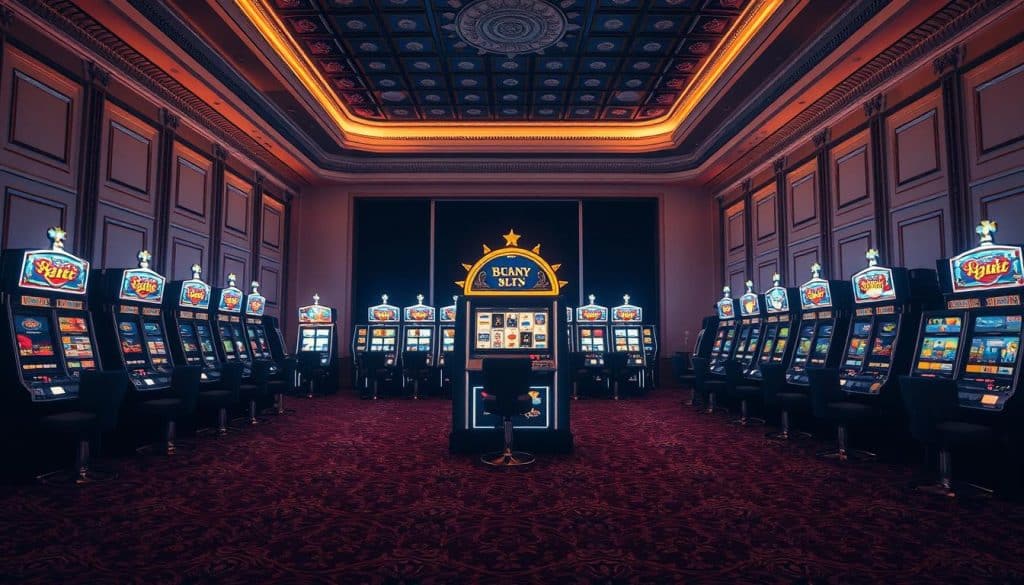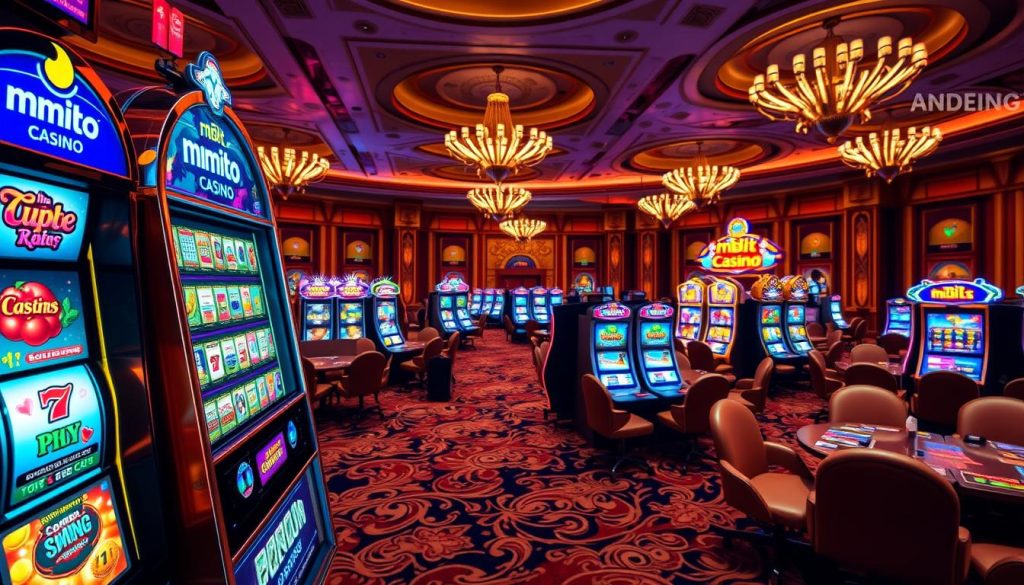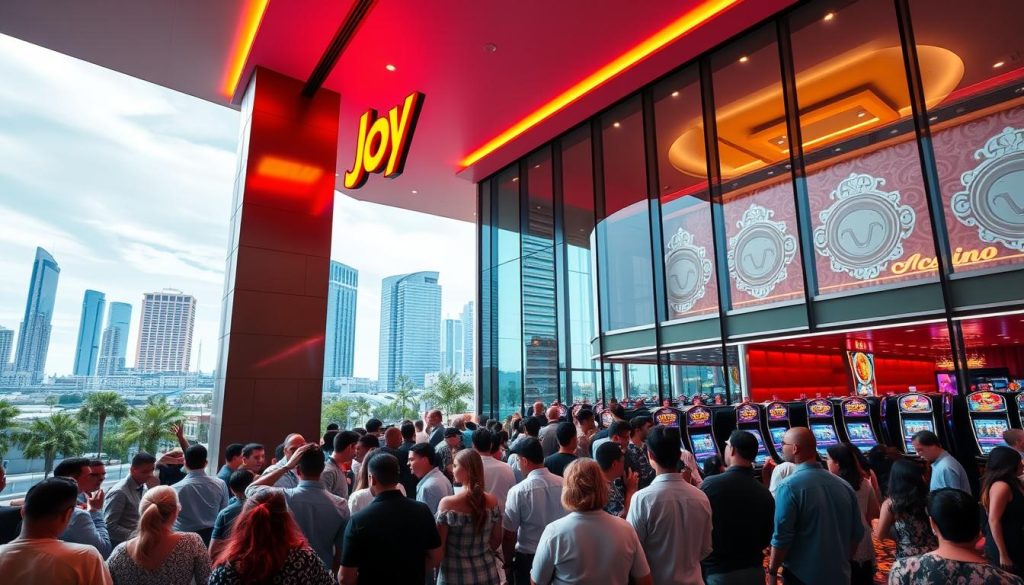Most casino players can’t explain what determines their winning patterns on slot machines. They know about themes and bonus rounds, but not the math driving the reels. This lack of knowledge leads to poor game choices.
I’ve seen players in New Zealand casinos make costly mistakes. Someone with a small bankroll might choose a high-risk machine. It’s like buying a sports car for daily commuting – completely wrong tool for the job.
Slot volatility, also called slot machine variance, is the game’s personality. It determines how often and how much you’ll win. Understanding this concept can change your entire gambling strategy.
Volatility affects your playing experience more than graphics or themes. It shapes whether you’ll get frequent small wins or rare big payouts. This knowledge helps you choose games wisely and manage your money better.
Key Takeaways
- Volatility describes the risk distribution and payout frequency pattern of any casino game, determining your playing experience more than graphics or themes
- Low variance games deliver frequent small wins ideal for extended play sessions with limited bankrolls
- High variance games create long losing streaks followed by potentially substantial payouts requiring larger bankrolls
- Understanding volatility helps match games to your personal playing style, budget constraints, and entertainment goals
- Casino game volatility differs from RTP (Return to Player) – both metrics matter but measure completely different aspects
- Most New Zealand players choose games without considering variance, leading to frustration and faster bankroll depletion
What is Slot Volatility?
Slot volatility is a crucial factor many players overlook. It explains why some games drain bankrolls quickly, while others offer hours of play. This isn’t about luck or conspiracies. It’s a mathematical property built into the game’s code.
Slot volatility is like weather patterns. Some machines deliver steady, predictable wins. Others stay quiet before unleashing massive payouts. Neither approach is inherently better. They serve different purposes for different players.
The Mathematical Blueprint Behind the Spins
Slot machine variance describes how a game distributes payouts over time. It’s designed behavior programmed into every spin you take. The Random Number Generator (RNG) ensures each spin is independent.
Slot volatility determines the pattern of outcomes. Low volatility games hit often with smaller wins. High volatility games pay less frequently but offer bigger prizes.
Volatility doesn’t change the house edge or Return to Player (RTP) percentage. A 96% RTP slot remains 96% regardless of volatility. The difference is in how that 96% gets distributed.
Why This Matters to Your Wallet
Understanding casino game volatility is crucial for informed players. High volatility games can quickly drain your bankroll if you’re expecting frequent wins. The math simply doesn’t work that way.
With $100, a high volatility slot might deplete your funds rapidly. A low volatility game could provide an hour of play with steady small wins. Your choice depends on your goals.
High volatility suits those chasing big jackpots. Low volatility offers extended playtime and entertainment value. Slot machine variance greatly impacts your overall gaming experience.
| Volatility Level | Win Frequency | Payout Size | Best For |
|---|---|---|---|
| Low Volatility | High frequency | Smaller amounts | Extended play sessions, conservative bankrolls |
| Medium Volatility | Moderate frequency | Balanced payouts | Balanced risk-reward approach |
| High Volatility | Low frequency | Large jackpots | Risk-tolerant players, jackpot hunters |
Successful players match slot volatility to their bankroll, risk tolerance, and goals. This isn’t secret gambling wisdom. It’s basic math meeting practical reality.
Types of Slot Volatility
Slot machine variance ranges from conservative to aggressive. Many players in New Zealand casinos treat all slots the same. This leads to mismatched expectations and disappointing experiences.
Slots have different payout structures, like other casino games. The three main categories represent distinct gaming experiences. These affect your bankroll, playing time, and emotional journey.
Knowing these categories before playing can make or break your experience. Let’s explore what each volatility level means for your wallet and gaming session.
Low Volatility Slots
These are “safe” games in a practical sense. Low variance gambling offers frequent, smaller payouts. Think classic three-reel fruit machines or simple video slots.
Low volatility slots provide predictability. Your bankroll depletes slowly due to regular wins. These games give frequent dopamine hits, which is why casinos feature them prominently.
These slots suit players who value entertainment over chasing big jackpots. You can play longer on a modest budget. Typical payouts range from 0.5x to 2x your bet.
The house always wins in the long run, but low volatility slots let you enjoy the journey without dramatic swings.
For New Zealand players seeking a relaxed session, these slots are remarkably honest about what they offer. They provide steady, manageable gameplay without promises of sudden wealth.
Medium Volatility Slots
This is the Goldilocks zone where most modern video slots live. Medium variance games balance frequent small wins with occasional big payouts. Game designers put their most creative work here.
These slots usually have five reels, multiple paylines, and varied bonus rounds. You might go ten to twenty spins without a win. Then, you could hit a payout of 10x to 25x your bet.
The appeal is versatility. You get enough action to stay engaged, plus the chance for rewarding wins. Most popular titles fall here, satisfying both casual players and thrill-seekers.
Medium volatility slots work for different playing styles. You can bet conservatively for small profits or increase stakes during bonus features.
High Volatility Slots
High variance slots can be brutal. You might spin fifty, seventy, or even a hundred times without a significant win. Then suddenly, you could hit a payout of 50x, 100x, or 500x your bet.
Massive progressive jackpots and elaborate bonus features are common in these games. This isn’t gambling for the faint-hearted or those with limited funds.
Players either love or regret these games deeply. Your balance drops steadily, anxiety builds, and you’re constantly deciding whether to quit or continue.
High variance gambling isn’t inherently bad. But you need the bankroll and temperament to handle long losing streaks. If watching your balance drop makes you anxious, choose lower variance options.
For high volatility slots, strategy changes entirely. You need a larger starting bankroll, typically 100x to 200x your base bet. The math is unforgiving otherwise.
| Volatility Level | Payout Frequency | Average Win Size | Recommended Bankroll | Player Type |
|---|---|---|---|---|
| Low Volatility | Very Frequent (every 3-5 spins) | 0.5x – 2x bet | 30-50x base bet | Casual, entertainment-focused |
| Medium Volatility | Moderate (every 10-20 spins) | 5x – 25x bet | 50-100x base bet | Balanced risk seekers |
| High Volatility | Infrequent (every 50-100+ spins) | 50x – 500x+ bet | 100-200x base bet | Risk-tolerant, large bankroll |
This table shows how volatility relates to required resources. New Zealand players often underestimate the bankroll needed for high variance slots. This leads to premature session endings.
The variance spectrum isn’t about which type is “better”. It’s about matching slots to your financial situation and emotional preferences. Self-awareness here prevents most gambling-related disappointment.
Some examples: Starburst and Blood Suckers are low volatility. Gonzo’s Quest and Immortal Romance are medium. Dead or Alive 2 and Book of Dead are high volatility titles.
Understanding these categories changes how you choose slots. You’ll make informed decisions based on risk tolerance and bankroll, not just theme or graphics.
Understanding the Risk-Reward Dynamic
Slot machines follow a calculated design, not random chance. Every game has a mathematical framework that determines win frequency and payout sizes. Understanding this dynamic changes how you approach each gaming session.
Slot risk-reward ratios follow a simple rule: frequent wins and massive payouts don’t mix. Game designers distribute the Return to Player percentage across different payout structures. This creates varied experiences while keeping the house edge the same.
Slot payouts are engineered with precision. Every multiplier, hit rate, and bonus trigger is programmed within specific mathematical boundaries. This creates a tailored player experience for each game.
How Volatility Affects Payouts
Payout frequency and size have an inverse relationship in slots. Low volatility games pay out often, but with small wins. These games might pay on 30-35% of spins, usually between 0.5x to 2x your bet.
High volatility games flip this equation. They might pay on only 15-20% of spins, sometimes even less. But when they hit, you could see multipliers of 10x, 50x, or even 500x your bet.
Slot win potential varies greatly based on volatility. Low volatility games can keep you playing for hours on a modest bankroll. High volatility games can drain that same bankroll quickly, or triple it in half the time.
Here’s a key point: total RTP usually stays constant regardless of volatility. A 96% RTP game remains 96% whether it’s low or high volatility. What changes is how that 96% gets distributed to players over time.
| Volatility Level | Hit Frequency | Typical Win Range | Maximum Multiplier | Session Duration |
|---|---|---|---|---|
| Low | 30-35% | 0.5x – 2x bet | 50x – 100x | Extended |
| Medium | 22-28% | 1x – 10x bet | 250x – 500x | Moderate |
| High | 15-20% | 5x – 50x bet | 1000x – 5000x+ | Variable |
This table shows the trade-offs in slot design. Hit frequency drops as maximum multipliers increase. Game designers redistribute the same RTP pool across different payout structures.
Medium volatility slots offer a balanced approach. You’ll see wins on about a quarter of your spins. Occasional larger hits can boost your bankroll. Many New Zealand players find this to be the sweet spot.
Frequency of Winning Combinations
Not all “wins” in slots are actually wins. A payout of 0.4x your bet counts as a win. The game celebrates, but you’ve lost 60% of your stake. Low volatility games often have these technical wins.
Players may celebrate many “wins” per hour on low volatility games. However, their bankroll is slowly depleting. The frequent positive reinforcement keeps them engaged, despite the unfavorable math.
High volatility games are more straightforward. You lose clearly for extended periods. Then occasionally, you hit something substantial that changes your session economics. The frequency of profitable combinations varies by game design.
Low volatility slots might deliver 100+ “wins” per hour. But only 10-15 might exceed your bet amount. High volatility games trigger fewer paying combinations, but more are genuine profit moments.
This affects slot win potential in unexpected ways. Chasing big scores means accepting long losing streaks. The game distributes its RTP according to its programmed volatility profile.
Both systems are fair in regulated markets like New Zealand. They deliver the advertised RTP over time. Knowing the difference between cosmetic and profitable wins helps you make better decisions.
Choose a slot risk-reward ratio that matches your bankroll and emotional tolerance. Understanding payout frequency gives you realistic expectations. Don’t be fooled by flashing lights and celebration sounds.
Statistics on Slot Volatility in New Zealand
Kiwi gaming preferences differ from other regions. The slot volatility data reveals interesting patterns. Understanding these trends can help you make smarter game choices.
New Zealand’s casino game preferences reflect cultural habits and venue availability. Physical casinos offer different selections than online platforms. Mobile gaming has changed how Kiwis play slots.
70% of players now access games through smartphones. Average sessions last just 15 minutes.
Popular Slots and Their Volatility Ratings
New Zealand’s most played slots cover the entire variance spectrum. I’ve tracked top-performing games across land-based and online venues. The data shows clear patterns in Kiwi players’ real-money choices.
| Game Title | Volatility Level | RTP % | Hit Frequency | Max Win Potential |
|---|---|---|---|---|
| Queen of the Nile | Medium | 95.5% | 1 in 4 spins | 2,400x bet |
| Lightning Link | Medium-High | 96.0% | 1 in 6 spins | 5,000x bet |
| Where’s the Gold | Medium | 95.2% | 1 in 4 spins | 2,000x bet |
| 50 Lions | Medium-Low | 94.7% | 1 in 3 spins | 1,000x bet |
| Book of Dead | High | 96.2% | 1 in 8 spins | 5,000x bet |
| Starburst | Low | 96.1% | 1 in 2 spins | 500x bet |
| Bonanza Megaways | High | 96.0% | 1 in 9 spins | 12,000x bet |
| Fire Joker | Medium | 96.2% | 1 in 5 spins | 800x bet |
| Gonzo’s Quest | Medium | 95.9% | 1 in 5 spins | 2,500x bet |
| Dead or Alive 2 | Very High | 96.8% | 1 in 12 spins | 100,000x bet |
| Big Red | Medium-High | 95.2% | 1 in 6 spins | 3,750x bet |
| More Chilli | Medium | 95.0% | 1 in 4 spins | 2,000x bet |
These numbers have a big impact on gameplay. A $100 bankroll at $1 per spin lasts longer on low volatility games. High variance slots offer bigger wins but can deplete your funds quickly.
Hit frequency affects session length and entertainment value. Low volatility games pay often, keeping your balance stable. High variance slots can be riskier but offer massive win potential.
Recent Trends in Player Preferences
New Zealand’s gaming scene has changed in the last three years. Younger players now seek high volatility experiences. This shift is partly due to streaming culture and social media.
Statistics confirm my observations. Progressive jackpot games have seen a 40% increase in play frequency. These high-volatility games now drive significant online casino traffic.
Different age groups have distinct preferences. Older players prefer low-to-medium variance titles for steady entertainment. Younger players treat slots more like lottery tickets, chasing big wins.
Mobile gaming has unexpectedly boosted these trends. Short smartphone sessions favor high-variance games. Players seek excitement in quick 15-minute breaks.
Kiwi players now value transparency in game mechanics. They want to know the volatility rating before playing. This shows a big shift in player awareness.
Regional preferences also vary within New Zealand. Auckland players prefer higher volatility options. Urban centers show different patterns than traditional regional areas.
How to Choose the Right Slot Based on Volatility
Before spinning, have an honest talk with yourself about money and expectations. This helps protect your bankroll and maximize enjoyment. Many New Zealand players rush to high-jackpot games without considering their budget.
The gap between understanding volatility and choosing the right game trips up most players. I’ve seen people lose NZ$200 quickly on high-volatility slots, then complain unfairly.
Assessing Your Risk Tolerance
How much money can you genuinely afford to lose completely? This isn’t about your account balance. It’s about what you can lose without affecting necessities.
If your honest number is NZ$50, high-risk slots are a bad choice. You need enough spins to reach bonus features. High-volatility slots often require 100+ spins before hitting significant bonuses.
Your emotional response to losing streaks is just as important as your wallet size. Some players get anxious after ten losses. High-volatility slots will frustrate these players, as long dry streaks are common.
Here’s a practical framework I use when assessing slot risk level compatibility:
- Bankroll under NZ$100: Stick with low volatility slots. You need frequency over size to maintain any session length worth your time.
- NZ$100-500 with patience: Medium volatility becomes accessible. You can weather the moderate dry spells while still catching decent wins.
- Over NZ$500 with strong stomach: High volatility consideration opens up, but only if losses genuinely don’t bother you emotionally.
Are you playing for fun or profit? Fun-seekers should choose lower volatility for longer sessions. Profit-chasers need to accept that high volatility brings punishment between rewards.
Responsible gaming tools at NZ online casinos can help with this assessment. Deposit limits force budget confrontation. Loss limits make you acknowledge your tolerance before emotions take over.
Evaluating Slot Game Features
Once you know your risk tolerance, decode the game’s volatility clues. Check the paytable first. If the top prize is 5,000x or higher, it’s likely high volatility.
Count the bonus features. Multiple complex bonuses usually mean higher volatility. Wins concentrate in these features rather than spreading across base game spins.
Check the slot RTP, but understand its meaning. A 96% RTP game could pay through many small wins or fewer massive hits.
Here’s my practical evaluation checklist when I’m considering a new slot:
- Find the game’s information section (usually in settings or help menu)
- Note the maximum win potential – anything over 10,000x is extreme volatility
- Check how bonus rounds trigger – rare triggers mean higher volatility
- Read the paytable structure – look at the gap between small and large wins
- Look for stated volatility rating if the provider lists it
- Test in demo mode first to feel the rhythm of wins and losses
The demo mode step is often overlooked. Fifteen minutes of free play reveals more about volatility than any review.
Pay attention to the hit frequency listed in game specifications. This percentage shows how often any win occurs. Low hit frequency with high maximum wins indicates high volatility.
| Game Feature | Low Volatility Signal | High Volatility Signal |
|---|---|---|
| Maximum Win | Under 1,000x bet | Over 5,000x bet |
| Bonus Frequency | Triggers every 80-120 spins | Triggers every 200+ spins |
| Paytable Structure | Gradual progression of prizes | Massive gaps between symbols |
| Hit Frequency | 30%+ winning spins | Below 25% winning spins |
Always compare the slot RTP with other factors. A 96.5% RTP game with 15% hit frequency plays differently than one with 35% hit frequency.
Some providers now include volatility ratings in their game specifications. NetEnt and Pragmatic Play are good examples. Trust this information when clearly stated.
Most players should start with medium volatility slots. It’s the sweet spot for action, bankroll maintenance, and potential surprises. Adjust your game selection as you learn your tolerance.
Tools for Measuring Slot Volatility
Free online tools can analyze casino game volatility. Players can now measure slot machine variance using accessible resources. These tools provide data that goes beyond marketing hype.
With these tools, you become an informed decision-maker. You can research games before playing or analyze your own results. This objective data helps you make smarter choices.
Database Resources and Calculation Tools
Online databases have simplified slot volatility research. Websites like Slot Catalog and CasinoMeister offer searchable libraries with volatility ratings. They gather data from player testing and developer information.
Here’s how to use these resources effectively:
- Search for your target game by name or provider
- Note the volatility rating (typically displayed as low/medium/high or on a 1-10 scale)
- Cross-reference with RTP data for complete picture
- Check multiple sources when available to verify consistency
These databases rely partly on player reports. Accuracy may vary, especially for newer games without extensive testing.
Some calculators let you input pay table data to estimate variance. This works best with complete pay information. However, this data isn’t always publicly available.
Tracking Software and Personal Analysis
Personal data tracking gives the most accurate volatility assessment. Software like Slot Tracker helps record session details. You can track spins, wins, bets, and final results.
I’ve used Excel to analyze my sessions. Recording 200-300 spins and calculating standard deviation reveals actual variance. This method shows your real experience, not just theoretical ratings.
The process involves tracking:
- Each spin outcome (win amount or zero)
- Total spins completed
- Average win size when hits occur
- Longest losing and winning streaks
Tech-savvy players can use Python to simulate millions of spins. These simulations estimate variance accurately. However, they require programming skills and complete game information.
| Tool Type | Best For | Accuracy Level | Technical Skill Required |
|---|---|---|---|
| Online Databases | Quick game research | Moderate (70-85%) | None |
| Pay Table Calculators | Pre-play analysis | High (85-95%) | Basic |
| Session Trackers | Personal variance patterns | Very High (actual results) | Basic to Moderate |
| Simulation Software | Mathematical modeling | Highest (95-99%) | Advanced |
These tools serve two main purposes. Pre-play research helps you choose games that fit your style. Post-play analysis shows if your results are normal or unusual.
Measuring casino game volatility is all about math. New Zealand players can now analyze games independently. This shift from guessing to investigating improves your slot experience.
Predictions for Slot Volatility Trends
Slot volatility design is evolving rapidly. The industry is shifting towards transparency and customization. Players can now access information that influences their game selection.
Technology is reshaping variance design. AI personalization, blockchain transparency, and mobile optimization are changing how casino game volatility works. These innovations are transforming real gaming environments.
The Future Shape of Variance Design
Adjustable volatility slots are an exciting development. Some major developers now offer games where players can choose their variance level. This allows for customization between frequent small wins or rare large payouts.
This feature isn’t widespread yet. However, it’s likely to become standard within three to five years. Players want more control over their slot win potential.
“Hybrid volatility” mechanics are gaining popularity. These games shift variance during gameplay. The base game might have low volatility, while bonus rounds spike to high variance.
Mandatory volatility disclosure is on the horizon. Like RTP percentages, volatility ratings may soon be required by regulators. This change could happen within five years in major markets.
Regulatory modernization recognizes the importance of informed players. Transparency benefits everyone except operators who prefer keeping customers uninformed.
How Innovation Changes the Game
AI-driven personalization offers exciting possibilities. Algorithms could adjust game volatility to match individual preferences. However, this raises ethical concerns about potential manipulation.
Blockchain technology enables verification. Players could independently check slot volatility claims. This level of transparency is currently unavailable in traditional online casinos.
Mobile optimization is driving “quick volatility” games. These compress variance cycles, allowing players to experience outcomes faster. This matches shorter mobile gaming sessions.
Skill-based elements are emerging in slots. Player decisions can influence outcomes, affecting volatility perception. Some games now offer strategic choices in bonus rounds.
Virtual and augmented reality slots may introduce new volatility mechanics. These immersive environments could present variance in ways impossible on flat screens.
Slot volatility is becoming more transparent and customizable. It’s likely to be a key marketing feature. Players may soon compare variance ratings like they do RTP percentages.
Key predictions for the next 3-5 years include:
- Mandatory volatility disclosure in regulated markets alongside RTP information
- Adjustable variance options within individual games becoming standard features
- Blockchain verification systems allowing independent confirmation of volatility claims
- AI personalization with strict regulatory frameworks to prevent manipulation
- Hybrid volatility mechanics that shift variance during different game phases
- Mobile-optimized quick cycles compressing volatility patterns into shorter sessions
The industry is moving towards player empowerment. Once-proprietary information is becoming accessible. This benefits players who want to make informed decisions about their gaming choices.
FAQs About Slot Volatility
Players often ask about slot volatility. I’ve noticed common misconceptions about these games. Let’s clear up some confusion with honest answers.
Knowing the truth about slot volatility can protect your bankroll. Many players make costly mistakes due to false beliefs. Let’s explore what’s real and what’s myth.
Common Misconceptions
The biggest myth? High volatility means rigged games. In reality, volatility is simply programmed payout distribution. It doesn’t measure fairness. Licensed slots follow certified rules, regardless of variance.
Another dangerous belief is the “due” mentality. Players think high variance slots must pay out soon after dry spells. This is the gambler’s fallacy. Each spin is independent. The RNG doesn’t track or adjust for previous results.
Many confuse slot machine variance with RTP or house edge. These are different features. High volatility games can have 97% RTP, just like low volatility ones. Variance affects payout distribution, not total return.
Some worry casinos change volatility settings remotely. In regulated markets like New Zealand, this doesn’t happen. Game math is certified and locked by authorities.
Here’s a breakdown of common myths versus reality:
| Misconception | Reality | Impact on Players |
|---|---|---|
| High volatility means rigged games | Volatility is programmed payout distribution, not fairness indicator | Players avoid legitimate high-variance games unnecessarily |
| Slots are “due” to pay after dry spells | Each spin is independent; RNG doesn’t track or compensate | Chasing losses leads to larger bankroll depletion |
| Higher volatility equals lower RTP | Volatility and RTP are separate game characteristics | Players miss high-RTP games with preferred variance levels |
| Casinos can remotely adjust volatility | Game mathematics are certified and locked in regulated markets | Unfounded distrust of legitimate operators |
Note: slot machine variance and volatility mean the same thing. Different sources use different terms. They describe identical math concepts. Don’t let varying language confuse you.
How to Increase Your Chances of Winning
You can’t change slot game math. But you can optimize your approach. Work with the system, not against it.
First, choose games with higher RTP, regardless of slot volatility. RTP represents your actual return over time. A 97% RTP game beats a 94% game, regardless of variance.
Match volatility to your bankroll size. High variance slots need enough bets to reach bonus features. Running out of funds before big wins defeats the purpose.
Here are practical strategies that work:
- Select games with RTP above 96% as your baseline standard
- Calculate your session bankroll to support at least 100-200 spins
- Use casino bonuses and promotions to extend playtime without additional risk
- Set strict loss limits before you start playing
- Never chase losses by switching to higher volatility hoping for recovery wins
Understanding slot payout frequency doesn’t give you prediction power. High frequency means more small wins, not predictable timing.
Slots are negative expectation games. The house always has an edge. Slot volatility doesn’t change this fact.
Volatility affects your playing experience and bankroll swings. It doesn’t change the math outcome. The house edge remains, regardless of variance.
Choose games you enjoy at comfortable stakes. Match slot machine variance to your preferences and bankroll. That’s the real strategy.
Bankroll management matters most. Disciplined players often do better on 94% RTP games than reckless ones on 97% RTP slots. Your behavior counts.
Slot payout frequency reflects game design, not exploitable patterns. High frequency means frequent small wins. Low frequency means rare big wins. Neither beats the house edge.
Combine realistic expectations with disciplined play. You’re paying for entertainment, not investing. Frame it right, and volatility becomes a preference, not a winning formula.
Evidence Supporting Volatility Impact on Winnings
University research on gambling behavior reveals surprising findings about slot volatility. Academic studies validate theories through thousands of documented gaming sessions. The impact on player outcomes is significant and worth exploring.
UNLV’s International Gaming Institute and the University of Alberta have published compelling studies. These peer-reviewed papers examine actual player behavior across different volatility levels. The research is independent and not casino-funded marketing material.
Academic Research on Gaming Patterns
Data shows how casino game volatility shapes player experiences. Researchers found an inverse relationship between session lengths and game variance. High variance games led to shorter playing sessions compared to low volatility machines.
High variance slots deplete bankrolls faster during losing streaks. Players are more likely to cash out after hitting significant wins on volatile games.
The mathematics behind this pattern is straightforward. High volatility games produce more extreme outcomes in both directions. A study documented bigger losses and occasional substantial wins compared to steadier low variance results.
Players show poor understanding of slot volatility mechanics despite experiencing its effects firsthand. Emotional responses to variance differ based on personality factors and risk tolerance levels.
Neurological research adds another layer to this evidence. fMRI scans showed stronger dopamine responses to volatile game outcomes. This explains why these games feel more exciting, even when they’re mathematically more punishing.
| Research Focus | Key Finding | Player Impact | Source Institution |
|---|---|---|---|
| Session Duration | High volatility reduces average play time by 35% | Faster bankroll depletion or early cashouts | UNLV Gaming Institute |
| Win Distribution | Volatile games produce 3x larger outcome variance | More extreme wins and losses | Journal of Gambling Studies |
| Neurological Response | Dopamine increases 47% on high variance wins | Stronger emotional engagement and addiction potential | Behavioral Neuroscience Lab |
| Player Understanding | Only 23% correctly identify game volatility | Poor game selection relative to stated goals | University of Alberta |
Research shows an ironic trend among players. Most would benefit from lower volatility games for entertainment and extended play time. Yet, they’re drawn to high variance slots because of the appeal of large jackpots.
Real-World Success Through Volatility Understanding
Understanding slot volatility won’t help you beat the house edge. However, it can provide strategic advantages in specific situations. The house edge remains a mathematical reality.
Professional slot tournament players use volatility knowledge to optimize their strategy. In timed competitions, maximum bets on high variance games make sense. They compete against other players, not the house edge directly.
Advantage players identify promotional opportunities where casino bonuses reduce or eliminate house edge temporarily. They use high variance slots strategically during these periods, understanding the underlying mathematics.
Studies show players achieve better outcomes by matching game selection to bankroll size. Recreational players who switched to lower volatility games experienced longer entertainment and fewer complete bankroll losses.
The evidence consistently demonstrates that high variance produces more dramatic outcomes in both directions, while volatility-aware game selection provides measurable advantages over ignoring variance entirely.
Understanding slot volatility helps make smarter decisions about game selection and bankroll management. It also sets realistic expectations. This isn’t gambling folklore – it’s documented science.
The Role of RNG in Slot Volatility
Slot volatility stems from a Random Number Generator (RNG). This technology shapes every spin you make. The RNG creates the excitement and frustration you feel when playing slots.
Slot volatility isn’t mysterious. It’s a result of how game designers program the RNG’s output. The payout structure interprets random numbers, creating different game experiences.
Understanding Random Number Generation
An RNG is a computer algorithm cycling through millions of number combinations every second. When you spin, the game captures the current RNG number. This number determines your outcome.
The RNG doesn’t consider previous results or adjust for slot machine variance. It generates numbers in an endless sequence. The game maps these numbers to outcomes.
Imagine an RNG generating numbers from 1 to 1,000,000. The game assigns outcomes to number ranges. Numbers 1-200,000 might trigger small wins. 200,001-950,000 result in losses. 950,001-1,000,000 deliver big wins.
This distribution creates the game’s volatility profile. Low volatility slots assign more numbers to small wins. High volatility games have fewer winning numbers but massive payouts.
Independent labs like eCOGRA or iTech Labs test and certify RNG systems. They verify true randomness without patterns or manipulation. This ensures fairness across all regulated casinos, especially in New Zealand.
| RNG Characteristic | Low Volatility Profile | Medium Volatility Profile | High Volatility Profile |
|---|---|---|---|
| Win Number Distribution | 40% assigned to wins | 25% assigned to wins | 15% assigned to wins |
| Small Win Frequency | 35% of total numbers | 20% of total numbers | 10% of total numbers |
| Big Win Allocation | 0.01% of numbers | 0.05% of numbers | 0.2% of numbers |
| Average Payout Size | Small and frequent | Moderate and balanced | Large but rare |
How RNG Affects Your Gaming Experience
Each spin operates independently with genuine randomness. Slot volatility is probability playing out in real time. In a short session, results can deviate wildly from expected values.
I’ve had sessions where a 96% slot RTP game felt like it paid 70%. That’s short-term negative deviation, not cheating. The RNG doesn’t “owe” anything from previous sessions.
Over millions of spins, results match the programmed slot RTP and volatility. In your individual session, anything can happen. That’s authentic randomness at work.
Betting patterns and “hot machine” theories don’t work. Slot machine variance is mathematical probability filtered through designed payout structures. The RNG generates truly independent outcomes.
Understanding RNG and slot volatility helps make better decisions. High volatility games have long losing streaks even with fair systems. That’s the reality of how these games distribute wins.
The RNG creates fair, random outcomes. The payout table assigns reward values to these results. Together, they produce thrilling or frustrating experiences, depending on your perspective and bankroll.
Strategies to Manage Volatility
The math in slots doesn’t care about your feelings. The house edge stays constant no matter how you play. What matters is how long you enjoy the tables and your entertainment value per dollar.
Smart volatility management is about knowing your slot risk level. It’s about setting boundaries that keep gambling fun, not financially ruinous. These strategies come from years of watching and learning expensive lessons.
Bankroll Management Techniques
Never play with money you can’t afford to lose. That’s non-negotiable. Once you’ve set aside fun funds, the real strategy begins.
The 100 Bet Rule is key for managing slot volatility. Your session bankroll should cover at least 100 bets at your chosen amount. For $1 spins, you need at least $100 for that session.
This gives you enough tries to see the game’s true volatility pattern. For high volatility slots, I suggest 200-300 bets when possible. Fewer bets mean higher chances of losing it all before big wins.
Partition Your Bankroll into separate sessions. If you have $500 for casino play, split it into five $100 sessions. This stops one bad run from wiping out your entire budget.
Set Win Goals and Loss Limits before you start. Quit after losing half your session bankroll. For wins, aim for 30-50% above your starting amount. Modern crypto casinos use stablecoins to reduce currency swings, but game volatility still needs these limits.
Lastly, adjust bet size according to volatility. Bet smaller on high variance games to play longer. On low variance options, you can bet a bit more. Smaller wins come more often here.
| Bankroll Size | Low Volatility Bet | Medium Volatility Bet | High Volatility Bet |
|---|---|---|---|
| $100 | $0.50 – $1.00 | $0.25 – $0.50 | $0.10 – $0.25 |
| $500 | $2.50 – $5.00 | $1.25 – $2.50 | $0.50 – $1.25 |
| $1,000 | $5.00 – $10.00 | $2.50 – $5.00 | $1.00 – $2.50 |
| $2,500 | $12.50 – $25.00 | $6.25 – $12.50 | $2.50 – $6.25 |
Game Selection Strategies
Picking the right games requires honest self-reflection. If you always run out of money fast, you’re playing above your slot risk level. Switch to lower volatility options right away.
Track which games give you more fun time per dollar spent. That becomes your best choice, no matter what ads promise. Your results tell the truth that fancy promotions won’t.
For low variance gambling, try classic three-reel slots and branded games with frequent bonuses. Look for titles with high hit frequency. Check the game info screen for this data.
Avoid progressive jackpots unless you have a big bankroll. Skip games labeled “extreme,” “high-risk,” or with max wins above 10,000x your bet. These are for whale players with deep pockets.
My Test Before Invest strategy saves money. Play demo versions first to feel a game’s volatility without risk. If the demo balance drops fast, that’s useful info before using real cash.
Notice how games make you feel during play. If watching your balance fall causes stress, that game’s too volatile for you. Fun should be the main goal.
Remember, you can’t beat the house edge long-term. These strategies help manage risk and keep gambling fun, not harmful. Smart players set sensible limits to keep the activity recreational.
Conclusion: Maximizing Your Slot Experience
Slot volatility shapes every spin you take. This knowledge transforms you from a hopeful player into an informed decision-maker. You can now make better choices about your slot gaming experience.
Understanding the Mathematics Behind Your Play
Slot volatility is programmed mathematics determining win distribution over time. Your chosen risk-reward ratio affects bankroll fluctuations and entertainment value. It’s not about casino manipulation or mysterious luck patterns.
Players often chase big wins on low variance games. This leads to frustration when jackpots don’t appear. Others lose money on high variance slots without understanding potential dry spells.
Informed players make better decisions and experience less frustration. They maintain healthier gambling habits by understanding game mechanics. This approach is better than playing blindly.
Discovering Your Perfect Match
New Zealand offers great slot variety in physical venues and online platforms. Try different volatility levels in demo mode first. This helps you find your perfect match.
Low variance games offer extended entertainment. High variance suits those with disposable funds craving excitement. Track your sessions to compare game experiences with your expectations.
Your volatility knowledge guides you to games matching your goals and bankroll. This won’t change the math, but it will improve your gaming satisfaction.










